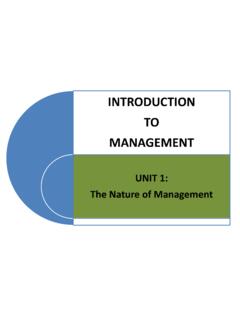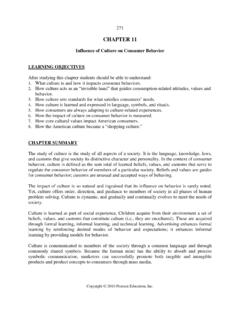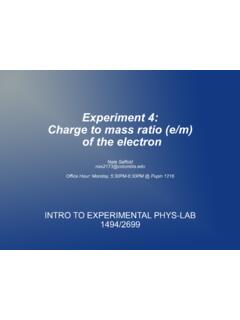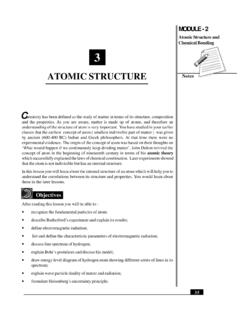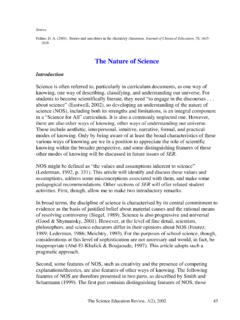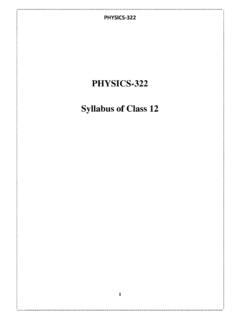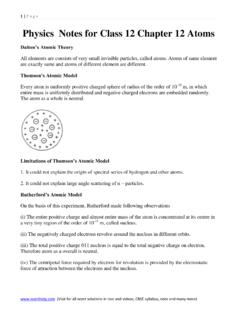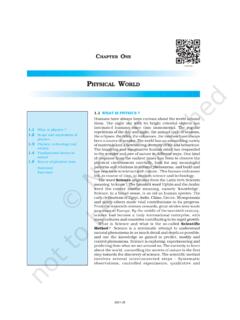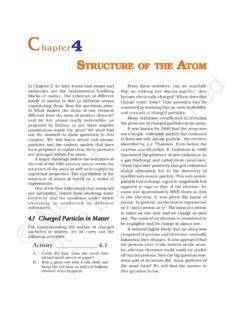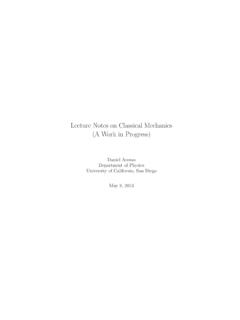Transcription of THE PERIODIC TABLE - NUST
1 THE PERIODIC TABLE . Dr Marius K Mutorwa COURSE CONTENT. 1. History of the atom 2. Sub-atomic Particles protons, electrons and neutrons 3. Atomic number and Mass number 4. Isotopes and Ions 5. PERIODIC TABLE Groups and Periods 6. Properties of metals and non-metals 7. Metalloids and Alloys OBJECTIVES. Describe an atom in terms of the sub-atomic particles Identify the location of the sub-atomic particles in an atom Identify and write symbols of elements (atomic and mass number). Explain ions and isotopes Describe the PERIODIC TABLE Major groups and regions Identify elements and describe their properties Distinguish between metals, non-metals, metalloids and alloys Atom Overview The Greek philosopher Democritus (460.)
2 370 ) was among the first to suggest the existence of atoms (from the Greek word atomos ). He believed that atoms were indivisible and indestructible His ideas did agree with later scientific theory, but did not explain chemical behavior, and was not based on the scientific method but just philosophy John Dalton(1766-1844). In 1803, he proposed : 1. All matter is composed of atoms. 2. Atoms cannot be created or destroyed. 3. All the atoms of an element are identical. 4. The atoms of different elements are different. 5. When chemical reactions take place, atoms of different elements join together to form compounds.
3 (1856-1940). 1. Proposed the first model of the atom. 2. 1897- Thomson discovered the electron (negatively- charged) cathode rays 3. Thomson suggested that an atom is a positively- charged sphere with electrons embedded in it. Ernest rutherford (1871-1937). 1. 1914- rutherford discovered the proton 2. rutherford model was based on the alpha particle scattering experiment 3. He proposed 1) all the positive charge of an atom is concentrated in the nucleus 2) an atom consists of a positively-charged nucleus with a cloud of electrons surrounding the nucleus Neils Bohr (1885-1962). He was a student of rutherford He proposed 1) electrons are arranged in orbits (electron shells) around the nucleus of the atom 2) electrons move in a particular path, have a fixed energy.
4 To move from one orbit to another, an electron must gain or lose the right amount of energy Atom Overview ATOM- is the smallest particle of an element that maintains the characteristics of that element ELEMENT- is a pure substance that cannot be split up into 2 or more simpler substances by chemical processes Atom is made up: Nucleus Electron cloud or shells Nucleus and electron cloud consists of 3 sub- atomic particles: Protons Neutrons Electrons What is an atom made of? The Nucleus Protons Positively charged particles in the nucleus Neutrons Particles of the nucleus that have no electrical charge Electron cloud/ shells Electrons Negatively charged particles in atoms Found around the nucleus within electron clouds Sub-atomic Particles Particle Charge Mass (g) Location Electron (e-) -1 x 10-28 Electron cloud Proton (p+) +1 x 10-24 Nucleus Neutron (no) 0 x 10-24 Nucleus Atomic Number Atoms are composed of identical protons, neutrons, and electrons How then are atoms of one element different from another element?
5 Elements are different because they contain different numbers of PROTONS. The atomic number of an element is the number of protons in the nucleus # protons in an atom = # electrons Atomic Number Atomic number (Z) of an element is the number of protons in the nucleus of each atom of that element. Element # of protons Atomic # (Z). Carbon 6 6. Phosphorus 15 15. Gold 79 79. Mass Number Mass number (A) is the number of protons and neutrons in the nucleus of an element: Mass # = p+ + n0. Nucleus p+ n0 e- Mass #. Oxygen - 18 8 10 8 18. Arsenic - 75 33 42 33 75. Phosphorus - 31 15 16 15 31. Complete Symbols Contain the symbol of the element, the mass number and the atomic number.
6 Superscript Mass number Subscript . Atomic number X. Symbol Form written in symbol form Mass number 35 symbol of Atomic 17 Cl the element number symbol tells us that the atom o is of element chlorine o has atomic number 17 (so it contains 17 protons). o has 17 electrons (number of protons = number of electrons). o has mass number 35 (so number of protons + number of neutrons = 35). o it must contain 35 17 = 18 neutrons Symbols Find each of these: a) number of protons b) number of 80. neutrons 35 Br c) number of electrons d) Atomic number e) Mass Number Symbols If an element has an atomic number of 34 and a mass number of 78, what is the: a) number of protons b) number of neutrons c) number of electrons d) complete symbol Isotopes Atoms of an element that have the same number of protons and electrons ,but different numbers of neutrons.
7 Hydrogen isotopes Hydrogen has 1 proton, 1 electron and 0 neutrons Deuterium has 1 proton, 1 electron and 1 neutron Therefore, it is heavier than hydrogen but has similar chemical properties and slightly different physical properties Tritium has 1 proton, 1 electron and 2 neutrons 23 24. Isotopes 11 Na 11 Na number of protons 11 11. number of electrons 11 11. number of neutrons 23 - 11 = 12 24 11 = 13. Ions Ion electrically charged particle Thus, atoms whose # of electrons does NOT. EQUAL the # of protons Either positively or negatively charged Positively charged = loses one or more electrons Negatively charged = gains one or more electrons Determining the charge of an ion: Overall charge = # of protons - # of electrons Symbol for Ions Includes: Atomic number Mass number Element symbol Charge Example: 35 protons, 45 neutrons, 36 electrons 80 -1.
8 Br 35. 12 protons, 12 neutrons, 10 electrons 24 +2. Mg 12. The PERIODIC TABLE In 1869,Dmitri Ivanovitch Mendel ev created the first accepted version of the PERIODIC TABLE . He grouped elements according to their atomic mass, and as he did, he found that the groups had similar chemical properties. Blank spaces were left open to add the new elements he predicted would occur. The PERIODIC TABLE PERIODIC Law - When the elements are arranged in order of increasing atomic number, there is a PERIODIC repetition of their physical and chemical properties Modern PERIODIC consists of: Periods - Horizontal rows of the PERIODIC TABLE (side to side).
9 Groups or families - vertical (up and down). column of elements in the PERIODIC TABLE The PERIODIC TABLE Groups Arranged by the # of valence electrons # of electrons in the outer shell Elements in the same group has same # of valence electrons Each group has similar chemical and bonding properties 8 groups Periods Arranged by increasing atomic number Elements in a period have the same number of electronic shells 7 periods PERIODIC TABLE 1 8. 2 345 67. Groups go down on the PERIODIC TABLE Elements in the same group, have the same number of valence electrons PERIODIC TABLE 1. 2. Periods go 3. across on the 4 PERIODIC TABLE 5.
10 6 Periods have the 7 same number of shells . Arrangement of electrons in the atom Electrons are arranged in energy levels Electron shells, around the nucleus Each energy level can only hold a certain # of electrons Arrangement of electrons in the atom Main rule electrons always go into the shell nearest to the nucleus, if the is room. Once the shell is filled up, the electrons go into the next available shell. Outermost shell of an atom is called the valence shell This shell should have electrons before it can be called a valence shell The electrons in the valence shell are called the valence electrons The Electronic Configuration of Atoms Mass number O.



